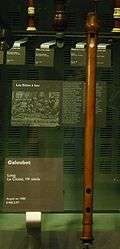Xirula
 | |
| Classification | |
|---|---|
| Related instruments | |
The xirula (Basque pronunciation: [ʃiˈɾula], spelled chiroula in French, also pronounced txirula, (t)xülüla in Zuberoan Basque; Gascon: flabuta; French: galoubet) is a small three holed woodwind instrument or flute usually made of wood akin to the Basque txistu or three-hole pipe, but more high pitched and strident, tuned to C and an octave higher than the silbote.[1] The sound that flows from the flute has often been perceived as a metaphor for the tweet cadences of bird songs.[2] Some scholars point out that flutes found in the Caverns of Isturitz and Oxozelaia going back to a period spanning 35,000 to 10,000 years ago bear witness to the early presence of the instrument's forerunner in the region, while this view has been disputed.[3]
Extent
It is an instrument characteristic of the Pyrenees, and it is played on the French side of the Basque Country (the extent of its use has shrunk over the years),[4] where it provides along with the atabal (a tabor-like instrument played with drumsticks) the musical background for various traditional dances. Besides performing the music for dances, in the former viscounty of Soule (Zuberoa in Basque) it may enliven accompanied on both the ttun-ttun and the atabal the traditional carnival-time performances called maskaradak as well as the pastorals, age-old region-specific theatre plays popular in the area.
It should be pointed out that like variants have been used to the west and east of the Basque Country up to the 1950s, with some examples occasionally jumping to the spotlight in special events, e.g. the so-called "gigantillos" (dancing characters with magnified masks and costumes) dancing to the tunes of the "chirola" in Burgos (Spain). The "silbu" and "chiflo" from Cantabria and Aragón show similar features.
Players
Main xirula activity focuses in Soule, where xirula's musical revival is led by Jean-Mixel Bedaxagar (1953) along with Mixel Etxekopar (1963).[2]
References
- ↑ "Txistu". Vitrifolk. Archived from the original on 2008-01-29. Retrieved 2008-03-17. Site in French
- 1 2 "Txori erresiñulak". Berria. Retrieved 2008-03-17. Site in Basque
- ↑ "La "basca tibia": El mito de la prehistoricidad del txistu vasco". Txistulari, 178. Retrieved 2009-06-15. Site in Spanish
- ↑ "EUSKAL MUSIKA: Basque Music". North American Basque Organizations. Archived from the original on May 21, 2008. Retrieved 06/02/2008. Check date values in:
|access-date=(help)